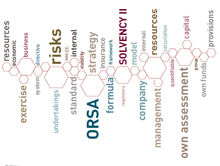You are in:
- Start
- Articles
- Solvency II: Own Risk and Solvency Assessment
Solvency II: Own Risk and Solvency AssessmentFINANCIAL
Joaquín Melgarejo.
Bachelor of Law
State Insurance Inspector (on extended leave)
Excursus
We have spent many years talking about Solvency II, but generally in the same terms, and almost always referring to the calculation of own resources that an insurance company or group must have under the new regulatory framework. Whatever the model chosen, the standard formula or an internal model, everyone agrees that this is an unprecedented challenge in the history of public insurance law and for supervision.
This is certainly right, but there are perhaps equally important aspects in Solvency II about which little has been written and which represent another challenge for the sector – namely the qualitative aspects of Pillar II.
It has been said that Pillar II is the real challenge and innovation in the new prudential regulations, inasmuch as it includes the need for exhaustive internal knowledge of what one wants to do –business strategy and governance–, how one wants to do it –human and material resources implemented– and the capacity to check for deviations from the initial plan– control, auditing and the other functions to which the Directive refers.
One of its basic tools is the “Own Risk and Solvency Assessment”, known colloquially by the acronym “ORSA”.
This article aims to give some outlines of a subject on which there is comparatively much less information, despite the fact that its implementation by insurers and groups is subject to the same deadlines as the rest of the provisions of Directive 2009/138/EC of 25 November.
It has been said that Pillar II is the real challenge and innovation in the new prudential regulations
The insurance company’s viability in the long term
If the purpose of the standard formula or an internal model is to calculate the capital that an insurance company or group of insurance companies should have in a year, seen in relation to current unexpected risks and any class of them which might arise in the next 12 months, the Solvency II Directive also refers to the company’s future viability, requiring the company to carry out a prospective exercise with respect to its future viability.
Through its ORSA, a company will be asked to measure the “slack” in its own resources compared with its total risk, thereby allowing its overall solvency in both the short and long term to be assessed.
In short, this is a prospective exercise based amongst other things on a company’s risk tolerance and appetite, its strategy and drawnup business plan, the macro scenario and the point in the cycle at which the assessment is carried out, the system of governance implemented, the quality of the own resources held, the possibility of adding new equity to the company should this be necessary, and the geographic and territorial diversification of its activity, amongst other factors.
Through its ORSA, a company will be asked to measure the “slack” in its own resources compared with its total risk, thereby allowing its overall solvency in both the short and long term to be assessed
Is the ORSA a novel feature of the Directive?
The form of the ORSA is not new; it exists in other financial sectors, including the insurance sector, having been included as part of best practice in the insurance sector and in the regulations of various countries, including Member States of the European Union.
Indeed, under the regulatory framework known as Basel II, the banking sector requires credit institutions to carry out a similar self-assessment exercise in the short and medium term1.
On the other hand, and within the context of insurance, the International Association of Insurance Supervisors (IAIS) has published a specific paper on the ORSA2 and, within the specific area of positive supervisory rules, this form has already been regulated by, amongst others, the NAIC3 in the USA and, closer to home, the UK’s Financial Services Authority (FSA), which has developed the Internal Capital Assessment (ICA).
In the Solvency II Directive there are only two articles that refer to the ORSA: Article 45 for individual undertakings and Article 246 relating to groups. Being something that cannot be delegated in the European Commission, it does not appear in the first draft developing level II rules, and in level III there is a paper which has yet to be approved by the European Insurance and Occupational Pensions Authority, EIOPA. As it does not appear in the proposed Omnibus II Directive as a binding matter at level III, the Member States will have to carry out a true regulatory exercise, since this is an exercise which is mandatory and recurrent over time.
How does the Solvency II Directive expect the ORSA to develop?
According to the literal wording of the Solvency II Directive, as a minimum this self-assessment exercise has to take account of overall solvency needs, taking into account the specific risk profile of the insurer carrying out the exercise, its risk tolerance approved by the Board of Directors, its business strategy and the extent to which the undertaking’s risk profile diverges from the assumptions on which the solvency capital requirement is based.
From the formal point of view, the self-assessment exercise must be put into practice using protocols, procedures or routines which make it possible to carry out the desired calculations and the checks and tests entrusted to them.
From the material point of view, there are three main aspects at least on which the ORSA focuses, namely: risks, commitments and own resources.
The ORSA must first of all capture all the risks that happen to the insurance undertaking, taking into account that, as the Directive says, “some risks may only be properly addressed through governance requirements rather than through the quantitative requirements reflected in the Solvency Capital Requirement. An effective system of governance is therefore essential for the adequate management of the insurance undertaking and for the regulatory system”.
Special consideration is given to verifying that the technical provisions are perfectly calculated, reflecting the insurer’s commitments over time. Consequently, the actuarial function is an input for the ORSA, as are the results of the internal control and audit.
The capital and own resources structure responds to the approach that “the limits applicable to own-fund items should only apply to determine the solvency standing of insurance and reinsurance undertakings, and should not further restrict the freedom of those undertakings with respect to their internal capital management”.
From the material point of view, there are three main aspects at least on which the ORSA focuses, namely: risks, commitments and own resources
Is an ORSA necessary?
The practical value of the ORSA is to integrate this self-assessment exercise into the company commercial strategy and day-to-day business. Consequently, the output of the assessment will make it possible to confirm or, where appropriate, adapt the company’s strategy in relation to aspects like product design, rating, capital needs (for the whole of the undertaking, by lines of business and also by product), asset allocation and structure, and so on.
Carried out with the necessary granularity, this should make it possible to check, for example, which lines of business are profitable, what rating policy or pricing ought to be adopted, what lines of distribution are advisable, and all of this to this extent to which, besides the traditional parameter of profit, other elements are incorporated into the decision, such as the risk which each policy or decision concentrates and the capital they consume.
The ORSA differs from the calculation of the regulatory capital in that it aims to determine the economic capital requirements, that is to say the own resources that must be contributed in order to pursue a particular business strategy
What is the difference between the role to be developed by the ORSA and that reserved for internal models?
The ORSA differs from the calculation of the regulatory capital, which represents the standard formula in which, through the exercise of selfassessment, the aim is to determine the economic capital requirements, that is to say the own resources that must be allocated in order to pursue a particular business strategy.
Differentiation from the standard formula is therefore easy, even if that is not so much the case with respect to the internal models implemented by undertakings. In the end, everything is going to depend on what the incorporated internal risk model is like, and on the deadlines for its implementation; however, there are some differences that can be proposed with respect to internal models that are used exclusively to calculate the regulatory capital or solvency capital requirement (SCR) – Pillar I.
Some of the differences that can be noted are:
- The reference time horizon, since the ORSA targets viability in both the short and long term, whereas the SCR looks for adequacy over a 12-month period.
- Whereas the ORSA aims to get closer to all the risks of the insurance company, being these quantifiable or not, the SCR, according to Article 101, aims to include all quantifiable risks.
- There would be other elements differentiating
both processes under the assumption
that the SCR seeks to calculate the regulatory capital while the ORSA focuses on calculating
the economic capital:
- The use of certain accounting criteria from the prudential perspective which have no reason to be used from a business perspective; for example, from the point of view of Solvency II, goodwill has no value even though it can have value from the economic perspective.
- The Directive allows certain assets to be calculated, and from the management perspective there is no reason for the same criterion to be established (recital 50 of the Directive).
- The Directive allows certain restrictions to be introduced into the calculation of assets, which may be applied in some Member States and not in others (recital 49 of the Directive).
- Prudential approach to the risk mitigation elements allowed in the Directive and applied differently in risk management (socalled residual risks).
- The methods used to quantify risks; effectively, where there is an internal model, the overall solvency assessment – the purpose of the ORSA – verifies amongst other things the goodness of the own model, which is why it does not appear that the same methods are used to assess risks in one case and in another.
- The management of own funds; while the SCR simply compares requirements with assets almost automatically, the ORSA appears to have to think about the suitability of own funds for the company’s strategy, including the possibility of bringing in additional funds should the need arise.
By way of conclusion
If QIS 5 (Quantitative Impact Study 5), as the realisation of the standard formula, has in the sector’s opinion proved to be a complicated exercise, the ORSA will be no less complex if it aims to compare the true risk profile of a company that has used standard parameters to quantify its risk profile.
There is still some way to go before we know how the ORSA will come into force in Spanish legislation, and it is desirable for the Member States to reach agreement at least on some guidelines on how to approach an exercise, the results of which must be notified to the Supervisor.
I think that the best way to end these brief notes is by doing so in the same way that this article began – if Pillar I represents an enormous challenge with its respective opportunities, the self-assessment exercise known as the ORSA looks like being no less of a challenge.
(1)See Banco de España,
Guía práctica de
Autoevaluación del Capital
de las entidades de crédito
(Practical guide to capital
self-assessment for credit
institutions) in the version
of 18 March 2009.
(2)Standard No. 2.2.6 of
October 2008: “Standard
on enterprise risk
management for capital
adequacy and solvency
purposes”.
(3)NAIC (National
Association of Insurance
Commissioners):
“ORSA for the Solvency
Modernization Initiative”,
6 August 2010.





